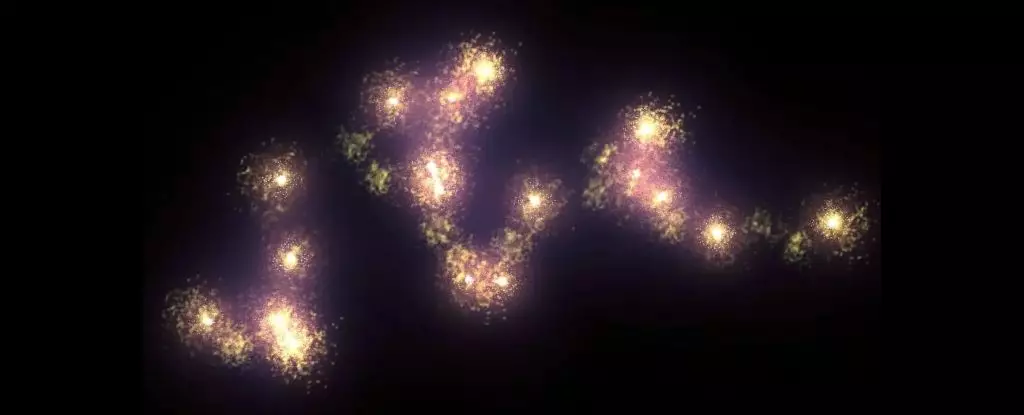The cosmic tapestry of the Universe continues to unravel with profound revelations that challenge our understanding and excite our imagination. A recent intensive investigation into gamma-ray bursts has illuminated the Hercules-Corona Borealis Great Wall, suggesting that this cosmic structure might be far larger than previously estimated. Initially thought to stretch 10 billion light-years, astronomers now contend that it could span an astonishing 15 billion light-years. This significant finding invites us to contemplate the very fabric of the Universe, raising questions about its fundamental nature and the limits of human knowledge.
Gamma-ray bursts (GRBs), among the Universe’s most explosive events, play an essential role in this discovery. These immense outbursts occur under extreme conditions, such as the collapse of a massive star into a black hole or when neutron stars collide. Given their prodigious brightness, GRBs serve as vital beacons, observable across immense cosmic distances. The association of gamma-ray bursts with massive stars, typically located in galaxies, allows researchers to map the distribution of these structures effectively.
Redefining What We Know
The Hercules-Corona Borealis Great Wall’s initial identification dates back over a decade, credited to astronomers István Horváth, Jon Hakkila, and Zsolt Bagoly. Their groundbreaking work was based on the examination of 283 gamma-ray bursts that exhibited an unusual clustering pattern—an aspect that required a deeper understanding. Now, re-evaluated data from a far greater number of gamma-ray bursts—542 in total—has enriched our celestial map, revealing that the Great Wall potentially extends from a redshift of 0.33 to 2.43. This newly minted measurement not only expands the scale of this cosmic structure but also reinforces its presence in the grand scheme of the Universe.
This astonishing revelation poses a conundrum for cosmologists. The traditional cosmological principle, which underpins our understanding of cosmic evolution, posits that the Universe appears homogeneous and isotropic on sufficiently large scales. This principle implies that there should not be drastic variations, or “bumps,” within the vast expanse of space. Up until now, structures larger than approximately 1.2 billion light-years have been considered significant outliers. However, with the Hercules-Corona Borealis Great Wall now looming at potentially 15 billion light-years, it forces a reevaluation of our conceptual frameworks.
A Universe of Surprises
Numerous immense structures have been cataloged in the cosmic landscape, including the Quipu at 1.3 billion light-years, and the Sloan Great Wall, also around 1.37 billion light-years across. This theme of discovery has persisted, with the announcement of the South Pole Wall reaching similar proportions in 2020. Other colossal formations, such as the Clowes-Campusano LQG at 2 billion light-years, and the Giant Arc at 3.3 billion light-years, further illustrate that the Universe is home to remarkable structures. Yet, none had prepared us for the sheer magnitude of the Hercules-Corona Borealis Great Wall, which now, with the latest data, stands as an enormous enigma.
Crucially, this discovery alleviates previous skepticism surrounding the existence of the Great Wall. Initial debates about its reality have seemingly subsided, lending credence to the idea that it is not the result of random statistical anomalies but a genuine celestial feature. With evidence mounting, the implications of such a find are profound. Yet, what precisely this immense wall signifies for our understanding of cosmic evolution remains largely unexplored. The enormity of this structural discovery invites fertile ground for discussion and hypothesis.
The Quest for Cosmic Answers
As we delve deeper into the cosmos and gather insights from phenomena beyond our planet, it becomes increasingly clear that the Universe retains hidden narratives waiting to be unveiled. Our current understanding of the cosmos is akin to a map drawn by an explorer who has only just begun their journey. Astonishing discoveries, such as the profound revelations surrounding the Hercules-Corona Borealis Great Wall, reflect the dynamic nature of scientific exploration. Each finding brings us closer to deciphering the mysteries of existence.
In a Universe that appears boundlessly intricate, we have merely scratched the surface. The pursuit of knowledge is a fundamental aspect of being human, and as we confront the enormity of cosmic structures like the Great Wall, we are invited to ponder our role within this vast expanse. The ongoing research and eventual publication by the team behind this discovery serve as a testament to human curiosity and the relentless quest for enlightenment—a pursuit that will continue to illuminate the Universe’s profound mysteries.


Leave a Reply